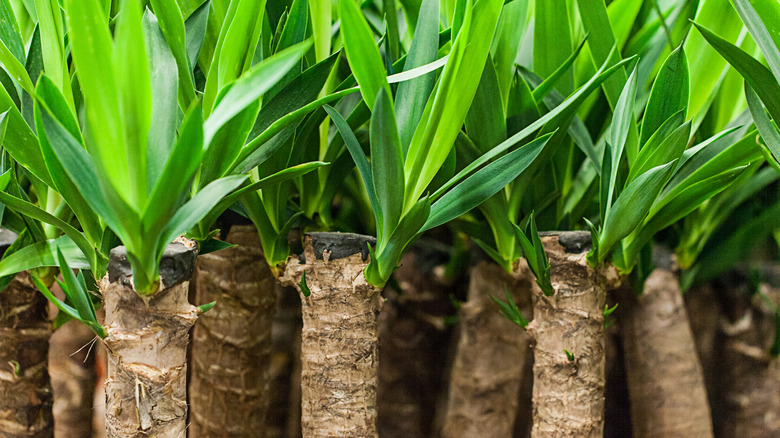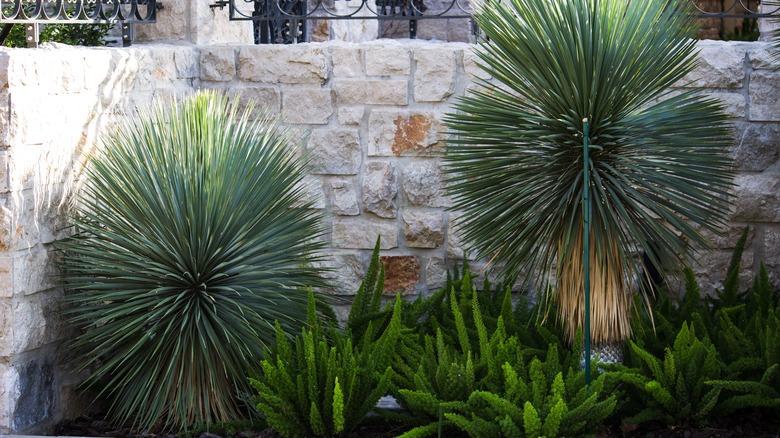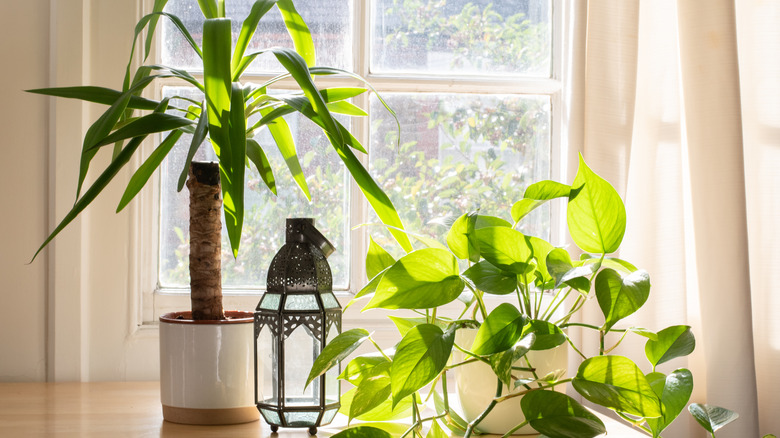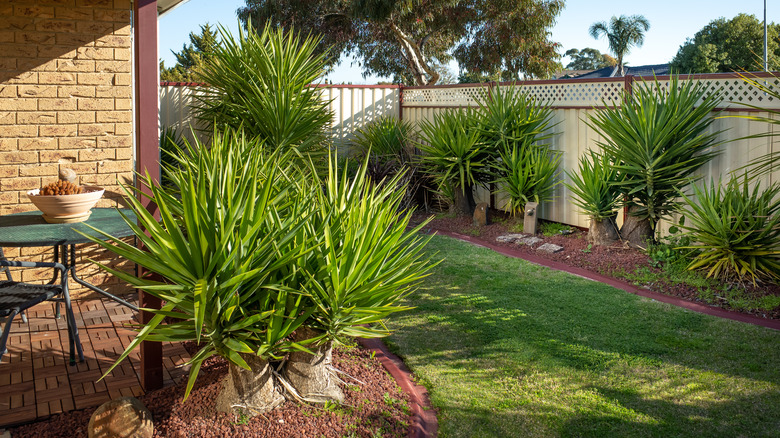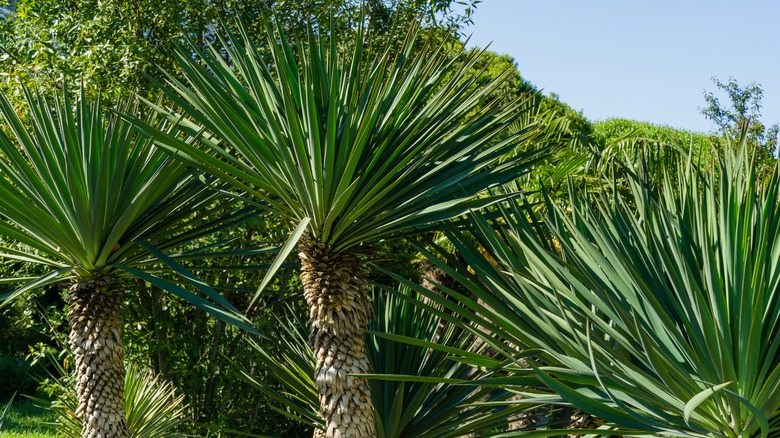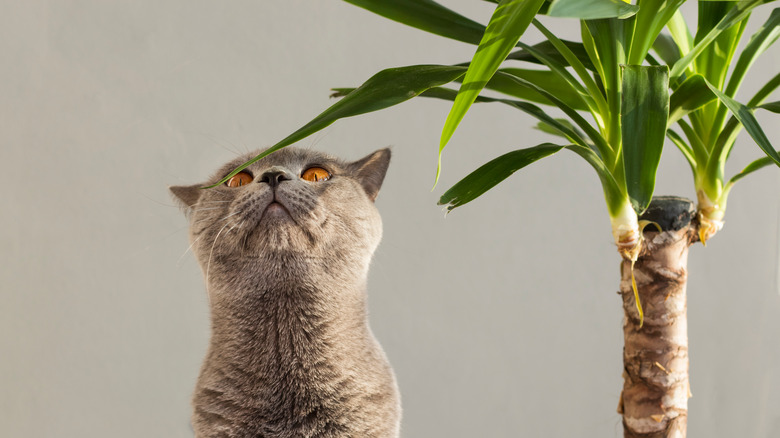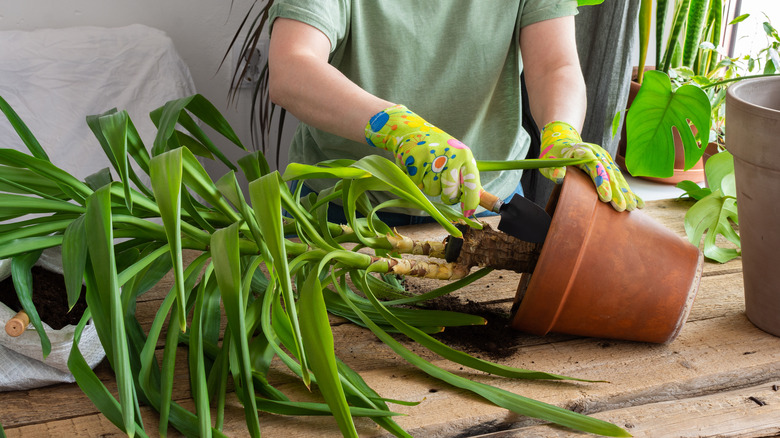How To Correctly Grow And Care For A Yucca Plant
In the genus of yucca, there are more than 40 species. All are perennial herbs and trees which are native to the hotter regions of the Caribbean and North America, according to The Spruce. Of the 40 species, only yucca elephantipes and yucca aloifolia can be grown indoors as houseplants. Many of their cousins can be grown in gardens, while others are almost always in the wild.
Nearly all yucca plants are characterized by long, sword-like leaves and occasionally white or pink flowers. Some leaves are longer, sharper, or greener than others, but once you begin to recognize each species' similarities, they won't be hard to spot. If you are growing yours indoors, you are unlikely to ever see your yucca bloom. These plants are fairly easy to grow since they are tolerant of neglect and don't require much water. They are slow-growing, but they can become too big for your home over time. Pruning your yucca plant regularly can help to keep them smaller longer.
How to use a yucca plant in the garden
Yucca plants are commonly used as garden plants, especially in arid regions of the U.S. such as Arizona, Texas, southern California, and parts of Nevada and New Mexico. Though, certain species of yucca, such as the yucca filamentosa, yucca gloriosa, and yucca baccata, can withstand colder weather towards the north, as per Garden Design. For the most part, yuccas are best in hardiness zones 5 to 11.
These species, as well as the yucca flaccida and yucca rupicola plants, make great additions to any garden. Their interesting, spikey form brings variety to your landscape. Since most of these species can grow quite tall and wide, it's best to plant them in an area where their growth will be accommodated. Keeping your yucca away from walkways is important, explained Gardening Know How. Most yucca species have sharp leaves known for causing injuries. Luckily, yucca plants require little maintenance when planted outdoors. If you plant them in a hard-to-reach background plot, you won't need to worry about them dying.
How to grow a yucca plant
Yucca plants can be grown from seeds and propagation. Alternatively, you could buy a young yucca from your local nursery or garden center to repot or plant into your garden. No matter how you decide to plant your yucca, you will need to start by finding some well-draining soil.
Growing a yucca from seeds is not recommended because it can take up to a year for them to sprout, said Gardeners HQ. After sprouting, they still have a low success rate for growing into adulthood. You can try this method by putting the seeds in a container with a paper towel soaked in water. Keep this container indoors at no colder than 65 degrees Fahrenheit. You will need to add more water as the paper towel dries. The seeds should sprout after one month to a year. After sprouting, you can plant the seeds in a new container with well-draining soil.
Most yucca plants are grown from root cuttings. According to The Spruce, you should propagate your plant in the fall when its growth has slowed. To begin, take your entire yucca out of its pot. Then, separate its rhizomes. Rhizomes are underground stems that grow horizontally. Cut off a 3- or 4-inch section and let it dry out for a few days before planting. Once planted in a pot with well-draining soil, it should sprout roots in less than a month.
How to care for a yucca plant
Yucca plants are very easy to care for once planted. They thrive in indirect sunlight, which means finding the perfect spot for them inside your home will take little effort. You should beware of intense direct sunlight as it can cause white spots on your yucca's leaves. No sunlight can also cause problems such as spindly growth, as told by Garden Design. When watering a yucca, underwatering instead of overwatering is better. These plants are very drought tolerant, but too much water can cause them to have yellow leaves and root rot. Plan to water your yucca every week with about an inch of water. In the winter months, you may switch to watering every other week or every 10 days.
If you planted your yucca outdoors, it should not need fertilizing. However, when young plants are planted in containers, they can benefit from some light fertilization, as per Gardening Know How. Before your yucca plant is established, feeding them with an all-purpose liquid fertilizer once per month may encourage healthy growth. Do this during the spring and summer seasons when your yucca is growing.
Yucca plant varieties
The yucca genus boasts more than 40 species and 20 subspecies. Each of these is native to the warm, arid regions of North and South America. Different species of yucca can be found in deserts, grasslands, low mountains, and even on the southern coastlines of the Atlantic ocean, according to Leafy Place. Here are five common yucca species you might choose to place in your garden.
-
Yucca filamentosa "Adam's Needle" is a shrub only grown outdoors due to its size. This yucca can grow up to 10 feet tall.
-
Yucca gloriosa "Mound Lily Yucca" is commonly found in eastern coastal states. It features white bell-shaped flowers and sharp green leaves.
-
Yucca baccata "Banana Yucca" is named for its banana-shaped fruit that tastes like a sweet potato.
-
Yucca flaccida "Weak-Leaf Yucca" features many sharp leaves which often break under their own weight. This plant is known to host yucca moth eggs more often than other species.
-
Yucca rupicola "Twistleaf Yucca" is one of the few yucca plants that doesn't have straight, sharp leaves. Instead, as the name implies, it has bright green leaves that twist and wave.
Is the yucca plant toxic?
Yucca plants are toxic to humans and pets. The ASPCA disclosed that they are toxic to dogs, cats, and horses due to their saponins. Saponins affect your pet's digestive system by causing diarrhea, vomiting, and cramps. It's best to keep this plant far away from your pet's reach. If you suspect that your pet has eaten a yucca leaf, immediately contact your nearest veterinary hospital.
The saponins inside yucca plants are not their only dangerous aspect. Most yucca plants are also incredibly sharp. You should never plant a yucca near busy walkways or other areas people or pets are likely to walk by, said Garden Design. Most yucca leaves can easily puncture through the skin. Since they are so tough, it's unlikely that they will break off while inside. Yet, when they do it can have even worse consequences. Saponins may be introduced into the body causing a reaction and prolonging the recovery period. Indoors or outdoors, always be mindful of yucca plants and watch your children and pets around them to avoid an accident.
How to repot a yucca plant
To repot a yucca plant, start by gathering your supplies. You'll need a medium or large pot with a draining hole and well-draining soil. Keep in mind that yucca plants do not need to be repotted often. They can live happily in the same pot for up to three years. According to The Spruce, large, mature yucca plants can be refreshed instead of repotted. Simply remove the top two inches of soil and replace it with new dirt.
Fully repotting your plant will only take a little more effort. Remove the entire plant from its original pot. If you are struggling to get it out, you can run a flat tool, such as a butter knife, along where the soil meets the pot. Once taken out, you can gently separate its roots and shake out the excess dirt. Place it in its new pot with fresh, well-draining soil and pack it gently around the base. Generously water your repotted yucca before placing it in a bright spot indoors or outdoors.
